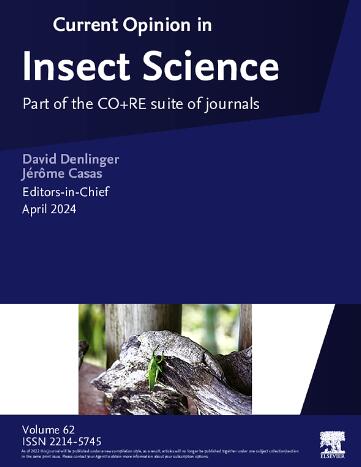Chemosensory and behavioral effects of Methoprene, a commonly used juvenile hormone analog and insect pesticide
IF 4.8
1区 农林科学
Q1 BIOLOGY
引用次数: 0
Abstract
Juvenile hormones (JH) regulate insect development, reproduction, and behavior. The JH analog Methoprene, widely used in pest control, disrupts these processes by inhibiting maturation rather than causing mortality. Beyond its physiological effects, Methoprene influences insect behavior, including mate choice, social organization, and foraging, by altering neuronal sensitivity and gene expression via the Methoprene-tolerant receptor. These behavioral disruptions may negatively impact insect populations, including pollinators like honeybees. While laboratory studies highlight Methoprene's behavioral consequences, field research is needed to assess its ecological effects. Understanding these broader impacts is crucial for evaluating the risks associated with JH-based pest control strategies.
甲基戊二烯的化学感觉和行为效应,一种常用的少年激素类似物和杀虫剂。
幼虫激素(JH)调节昆虫的发育、繁殖和行为。JH类似物甲基戊二烯广泛用于害虫防治,通过抑制成熟而不是导致死亡来破坏这些过程。除生理作用外,甲基戊二烯还通过耐甲基戊二烯受体改变神经敏感性和基因表达,从而影响昆虫的行为,包括配偶选择、社会组织和觅食。这些行为破坏可能会对昆虫种群产生负面影响,包括蜜蜂等传粉媒介。虽然实验室研究强调了甲基戊二烯的行为后果,但需要实地研究来评估其生态影响。了解这些更广泛的影响对于评估以jh为基础的虫害防治战略的相关风险至关重要。
本文章由计算机程序翻译,如有差异,请以英文原文为准。
求助全文
约1分钟内获得全文
求助全文
来源期刊

Current opinion in insect science
BIOLOGYECOLOGYENTOMOLOGY-ECOLOGY
CiteScore
10.40
自引率
1.90%
发文量
113
期刊介绍:
Current Opinion in Insect Science is a new systematic review journal that aims to provide specialists with a unique and educational platform to keep up–to–date with the expanding volume of information published in the field of Insect Science. As this is such a broad discipline, we have determined themed sections each of which is reviewed once a year.
The following 11 areas are covered by Current Opinion in Insect Science.
-Ecology
-Insect genomics
-Global Change Biology
-Molecular Physiology (Including Immunity)
-Pests and Resistance
-Parasites, Parasitoids and Biological Control
-Behavioural Ecology
-Development and Regulation
-Social Insects
-Neuroscience
-Vectors and Medical and Veterinary Entomology
There is also a section that changes every year to reflect hot topics in the field.
Section Editors, who are major authorities in their area, are appointed by the Editors of the journal. They divide their section into a number of topics, ensuring that the field is comprehensively covered and that all issues of current importance are emphasized. Section Editors commission articles from leading scientists on each topic that they have selected and the commissioned authors write short review articles in which they present recent developments in their subject, emphasizing the aspects that, in their opinion, are most important. In addition, they provide short annotations to the papers that they consider to be most interesting from all those published in their topic over the previous year.
 求助内容:
求助内容: 应助结果提醒方式:
应助结果提醒方式:


